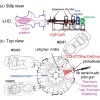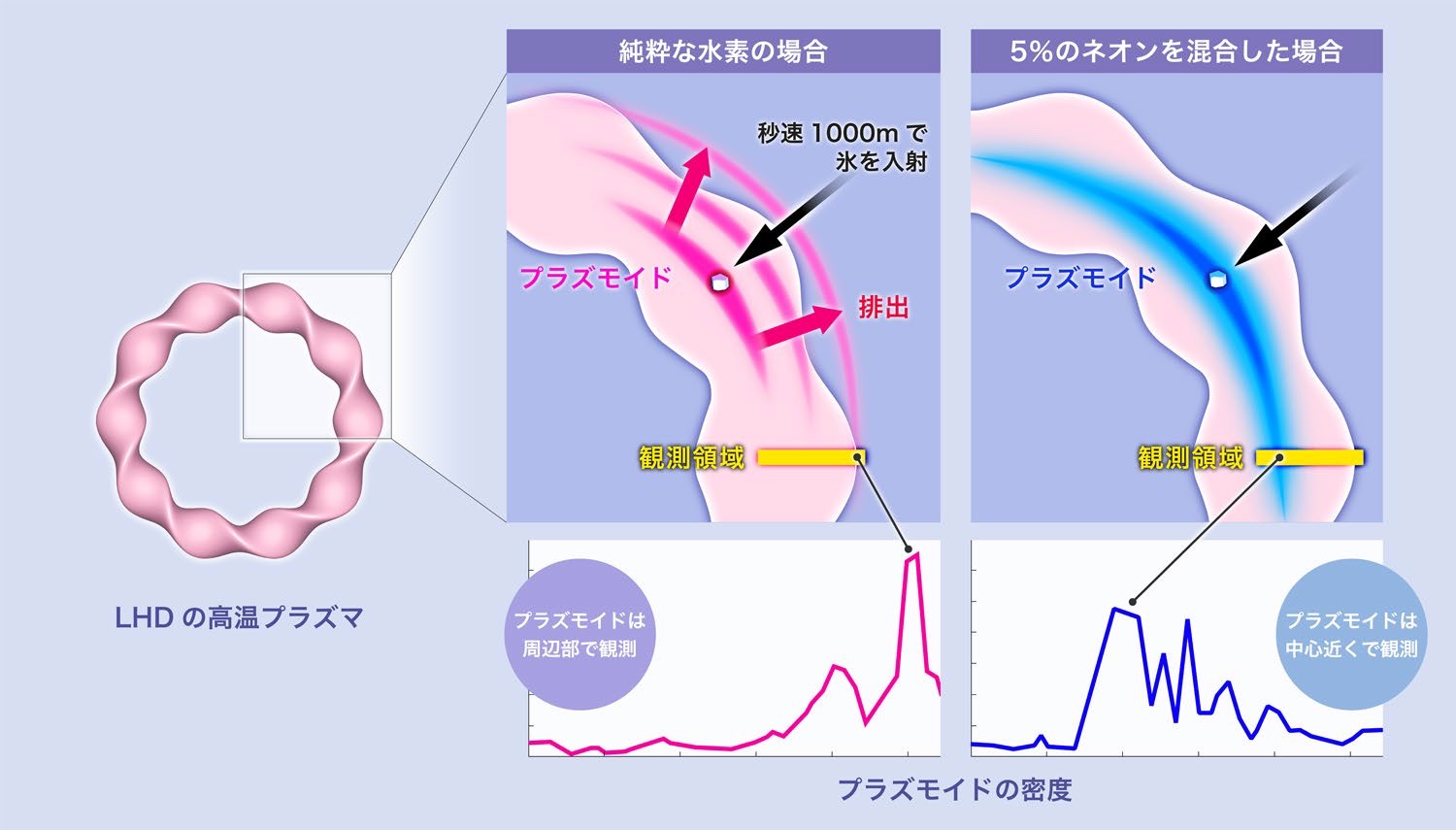

100 million degree plasma: Cooling ITER with ice grains!
ー Japan’s National Institutes for Quantum and Radiological Science and Technology Provides Cooling Technology ー
National Institutes for Quantum and Radiological Science and Technology:
-Large Helical Device (LHD) experiment-
In a high-temperature plasma confined by a magnetic field,
If you inject neon-added hydrogen ice grains,
We have demonstrated that high-temperature plasma can be effectively cooled to the depth.
Experimental Fusion Reactor ITER (ITER):
-Measures against instability of high-temperature plasma-
For ITER, “technology for forcibly cooling high-temperature plasma” is required.
This time, we clarified the “effects that influence the cooling system essential for ITER operation”.
overview:
– Fusion Experimental Reactor (ITER) under construction in France –
“High-temperature plasma confined by a magnetic field becomes unstable and is released.”
It may interfere with the execution of nuclear fusion experiments.
Countermeasures against the phenomenon called “disruption” are necessary.
Technology for forced cooling of plasma:
(disruption mitigation)
Japan’s National Institutes for Quantum and Radiological Science and Technology developed the technology.
It is possible to “catch signs of instability and forcefully cool the plasma.”
Add Neon:
Added “about 5% neon to hydrogen ice”.
Compared to incident pure hydrogen ice,
We clarified that it is possible to cool down to the deep part of the plasma.
– National Institutes for Quantum and Radiological Science and Technology
https://www.qst.go.jp/site/press/20221223.html
Plasma à 100 millions de degrés : Refroidir ITER avec des grains de glace !
ー Les instituts nationaux japonais pour la science et la technologie quantiques et radiologiques fournissent une technologie de refroidissement ー
Instituts nationaux des sciences et technologies quantiques et radiologiques :
-Expérience de grand dispositif hélicoïdal (LHD)-
Dans un plasma à haute température confiné par un champ magnétique,
Si vous injectez des grains de glace à l’hydrogène additionnés de néon,
Nous avons démontré que le plasma à haute température peut être efficacement refroidi en profondeur.
Réacteur de Fusion Expérimental ITER (ITER):
-Mesures contre l’instabilité du plasma à haute température-
Pour ITER, une “technologie de refroidissement forcé du plasma à haute température” est requise.
Cette fois, nous avons précisé les “effets qui influencent le système de refroidissement indispensable au fonctionnement d’ITER”.
Aperçu:
– Réacteur expérimental à fusion (ITER) en construction en France –
“Le plasma à haute température confiné par un champ magnétique devient instable et est libéré.”
Il peut interférer avec l’exécution d’expériences de fusion nucléaire.
Des contre-mesures contre le phénomène appelé « disruption » sont nécessaires.
Technologie de refroidissement forcé du plasma :
(atténuation des perturbations)
Les instituts nationaux japonais des sciences et technologies quantiques et radiologiques ont développé la technologie.
Il est possible “d’attraper des signes d’instabilité et de forcer le refroidissement du plasma”.
Ajouter du néon :
Ajout de “environ 5 % de néon à de la glace d’hydrogène”.
Par rapport à la glace d’hydrogène pur incidente,
Nous avons précisé qu’il est possible de refroidir jusqu’à la partie profonde du plasma.
– Instituts nationaux des sciences et technologies quantiques et radiologiques
100-Millionen-Grad-Plasma: ITER mit Eiskörnern kühlen!
ー Japans National Institutes for Quantum and Radiological Science and Technology bieten Kühltechnologie ー
National Institutes for Quantum and Radiological Science and Technology:
-LHD-Experiment (Large Helical Device)-
In einem von einem Magnetfeld eingeschlossenen Hochtemperaturplasma
Wenn Sie mit Neon versetzte Wasserstoffeiskörner injizieren,
Wir haben gezeigt, dass Hochtemperaturplasmen effektiv bis in die Tiefe gekühlt werden können.
Experimenteller Fusionsreaktor ITER (ITER):
-Maßnahmen gegen Instabilität des Hochtemperaturplasmas-
Für ITER wird „Technologie zur Zwangskühlung von Hochtemperaturplasma“ benötigt.
Diesmal haben wir die „Auswirkungen, die das für den ITER-Betrieb wesentliche Kühlsystem beeinflussen“ geklärt.
Überblick:
– Fusion Experimental Reactor (ITER) im Bau in Frankreich –
“Durch ein Magnetfeld eingeschlossenes Hochtemperaturplasma wird instabil und wird freigesetzt.”
Es kann die Durchführung von Kernfusionsexperimenten stören.
Gegenmaßnahmen gegen das Phänomen „Disruption“ sind notwendig.
Technologie zur Zwangskühlung von Plasma:
(Störungsminderung)
Die Technologie wurde von den japanischen National Institutes for Quantum and Radiological Science and Technology entwickelt.
Es ist möglich, “Anzeichen von Instabilität zu erkennen und das Plasma gewaltsam abzukühlen”.
Neon hinzufügen:
„etwa 5 % Neon zu Wasserstoffeis“ hinzugefügt.
Im Vergleich zu einfallendem reinem Wasserstoffeis
Wir haben klargestellt, dass es möglich ist, bis in den tiefen Teil des Plasmas abzukühlen.
– National Institutes for Quantum and Radiological Science and Technology
Enhanced Material Assimilation in a Toroidal Plasma Using Mixed H2+NePellet Injection and Implications to ITER
Phys. Rev. Lett. 129, 255001 (2022) –
ABSTRACT
The ablation and assimilation of cryogenic pure H 2 and mixed H 2 + Ne pellets,
which are foreseen to be used by the ITER tokamak for mitigating thermal and electromagnetic loads of major disruptions,
are observed by spatially and temporally resolved measurements.
It is experimentally demonstrated that
a small fraction (here ≈ 5 % ) of neon added to hydrogenic pellets enhances the core density assimilation with reduced outward transport for the low magnetic-field side injection.
This is consistent with theoretical expectations that
line radiation increased by doped neon in dense plasmoids suppresses the plasmoid pressure and reduces the → E × → B transport of the ablated material.